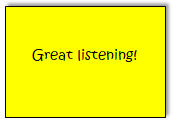Given nearly 30 years of experience as an occupational therapist, Tracey Cooper has a wealth of knowledge to share with fellow occupational therapists and special educators in today's ALIST Spotlight. Check out the post below from Tracey to learn more about the wonderful interventions and supports she provides to her students:
"I started in the medical model and transitioned to the school setting over 20 years ago. I am employed by Clark County ESC and have had the honor to work in the Tecumseh Local School district during these 20 years and several years in the Clark Shawnee school district. I work closely using a collaborative team approach with the Occupational Therapy Assistants, Intervention Specialists, Teachers, parents, other related service providers, and the special education departments with the goal of meeting the students’ physical, mental, and emotional needs using a holistic, positive approach.
Interventions:
Zones of Regulation and Sensory Rooms: I have had so much fun
working collaboratively with my teams to individualize a sensory room for each
building to meet student needs. We have
developed a consistent check in and out system using the Zones of Regulation and utilize visual supports for a
structured routine to facilitate regulation for school readiness. The rooms
were designed with a more active side and a calm side of the room. An IS is a key point of control for each
building who continues to collaborate with OT and PT for student success.
Movement Motor Pathways: In addition to the sensory rooms, movement motor pathways have been integrated into many of the buildings where I work. I have met with the principal of the building and other team members collaboratively for philosophy, different options, environmental considerations and some of the buildings have moved forward to install sensory motor pathways. The pathways have a systematic approach to being utilized for classrooms or individual students during the school day.
Integrating Course Work: Yoga for classrooms, Brain gym, and S’cool
Moves are courses I have attended and integrate into the classroom and school
community to advocate for student movement needs.
Self-care/Life Skills: Self-care needs have
grown in the schools. I work
collaboratively with the teachers and families to integrate student needs into
academics for more consistent practice for skill acquisition. I use Fine Motor Boot Camp, Self-Care with
Flare, hand strengthening and manipulation activities integrated into academics
such as hole punching with counting, daily tying practice, and sequencing
skills to make a sandwich just for a few examples. I meet with the special education
supervisor so that we can help guide teachers with life skill recommendations
to build the needed motor skills for students, such as crossing midline and
using two hands to sweep.
Handwriting Components: To address handwriting
skills, I begin with the components for handwriting, then progress to
integrating more task demands to compile the skills needed for independent
writing. Handwriting Without Tears curriculum is the main program integrated
into therapy using evidence based concepts and approaches to develop the
components for writing skills. In
therapy I task grade to help students develop the writing skills for the
classroom setting using visually modified paper, visual editing checklists,
helping teachers with modifying tasks in the classroom setting such as
journals, simplifying worksheets, agendas, integrating visual tracking
activities, modifying placement student desk, posture needs, and so much more.
School Community and Collaboration: School community is key for
the holistic approach to the student in the school setting. Looking at the student needs functionally in
a variety of settings including lunch, recess, specials, sports is beneficial
to make sure the student can participate in all areas at school.
Utilizing school resources in the community where students help other students is a philosophy I integrate. In previous years the wood shop has made slant boards and scooters boards. The vocational agriculture class has made materials for students to assemble planters. The PTO has donated money for sensory room resources. The tennis coach has donated tennis balls to integrate into hand strengthening resources.
In order to build team unity and continue in collaborative approaches to student success, I have created and facilitated grade-level in-services, building in-services, worked with Mental Health Therapists to present a one-day district in-service, as well as communicate regularly with teachers, intervention specialists, school psychologists, building principals, special education teams and staff.
I take every educational opportunity and utilize a highly collaborative team approach in my districts to support both teacher and student needs to ensure success and support for students within the educational environment. My overarching goal is to ensure students are living their lives to the fullest, not only in school building environments, but will also be able to transfer skills learned and gained while in therapy into their life for maximized independence and success. My passion is to create, design, and grow departments that are highly collaborative teams and centered around the students’ needs, interests, and success.
I am blessed as I love being an OT!"
And we are blessed to have Tracey as one of our ALISTers! Thank you Tracey for being such a wonderful partner to our team and for your dedication to best practices for us to share with others! Your students are so fortunate to have you!






















































